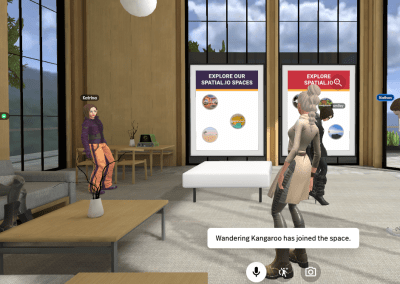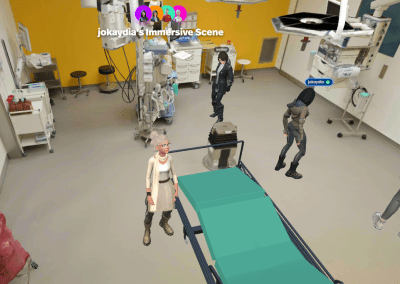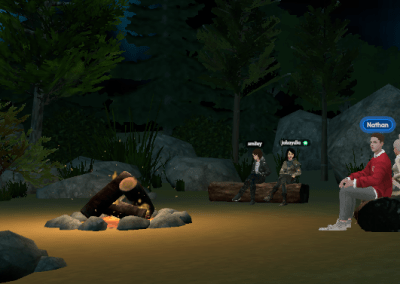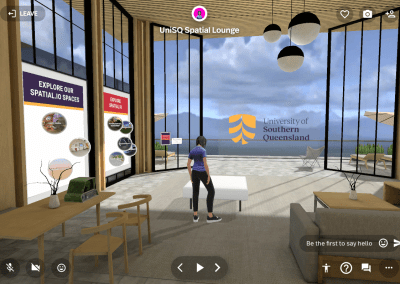
Special Interest Group – Virtual Immersive Environments
Technology Demonstrators > Special Interest Groups > Virtual Immersive Environments SIG
About the Virtual Immersive Environments SIG
The Virtual Immersive Environments SIG will be engaging members to think differently about learning environments through a systematic approach to the best practice use of virtual immersive environments. In our context we will investigate a range of VIEs to design bespoke experiences for each context and educational challenge. This may include an experience in which the user
a) wears a headset or
b) navigates an avatar in a digital space (computer, tablet, phone).
They may be pre-made spaces or ones in which we create content and experiences.
Providing VIEs for our students has the capacity to:
- bring all students (online and on-campus) in to the one space to participate in the same activities;
- design and build stories for presentation and collaboration;
- experience environments similar to the ‘real world’ in relation to physics, topography, spatially and interact with objects as if in the ‘real world’;
- undertake experiments that are otherwise too expensive or risky to do in the ‘real world’
VIEs provide opportunities to:
- create environments leading to deeper understanding of concepts particularly useful to students of architecture, design and education.
- experience places that cannot otherwise be visited – Space, remote locations, fantastical realities
- develop a deeper understanding of how to undertake clinical work particularly useful for nursing, health and education
- interact with people and places in different cultural settings and languages
Spatial Resources
Spatial Room URLs
What’s New
The last SIG meeting was on Wednesday April 12 at 1pm in the Ampitheatre. You are invited to go in at anytime.
The next SIG meeting – TBC
Resources
Dalgarno, B., & Lee, M. J. W. (2010). What are the learning affordances of 3-D virtual environments? British Journal of Educational Technology, 41(1), 10-32. https://doi.org/10.1111/j.1467-8535.2009.01038.x
Dalgarno, B., Gregory, S., Carlson, L., Lee, M. J. W., & Tynan, B. (2013). A systematic review and environmental analysis of the use of 3D immersive virtual worlds in Australian and New Zealand higher education institutions. Final report 2013 (dehub Innovation in distance education) http://dehub.edu.au/publications/books/
Dede, C. (2009). Immersive interfaces for engagement and learning. Science, 323(5910), 66-69. https://www.science.org/doi/pdf/10.1126/science.1167311
Jacka, L. (2015). Virtual worlds in pre-service teacher education: the introduction of virtual worlds in pre-service teacher education to foster innovative teaching-learning processes [Southern Cross University]. https://researchportal.scu.edu.au/discovery/fulldisplay/alma991012821255202368/61SCU_INST:ResearchRepositor
McGee, B. L., & Jacka, L. (2021). Virtual reality in education. Broken promises or new hope? In Gregory, S., Warburton, S., & Schier, M.(Eds.),Back to the Future –ASCILITE ‘21. Proceedings ASCILITE 2021 in Armidale (pp. 74–80). https://doi.org/10.14742/ascilite2021.0111
Savin-Baden, M., Gourlay, L., Tombs, C., Steils, N., Tombs, G., & Mawer, M. (2010). Situating pedagogies, positions and practices in immersive virtual worlds. Educational Research, 52(2), 123 – 133. http://www.informaworld.com/10.1080/00131881.2010.482732
Warburton, S. (2009). Second Life in higher education: Assessing the potential for and the barriers to deploying virtual worlds in learning and teaching. British Journal of Educational Technology, 40(3), 414-426. https://doi.org/10.1111/j.1467-8535.2009.00952.x
Read the Blog
Visit our conversations page to read about this topic and more.
Feedback Fruits Pilot
In 2022/23 we piloted Feedback Fruits. While we didn't continue with the use of the tool we made...
Dr Lisa Ryan
Conversations: TechDem ChampsTechnology Demonstrators > TechDem ChampionsDr Lisa Ryan Lecturer...
Associate Professor Jess Carniel
Conversations: TechDem ChampsTechnology Demonstrators > TechDem ChampionsJess Carniel Associate...
Footsteps on the Sands of AI for Higher Education: Moving Beyond Ad-Hoc
Lisa Jacka and Julie Lindsay discuss the challenges and opportunities presented by AI, focusing on academic efficiency, learning design, and assessment and highlight the ethical considerations surrounding AI use, advocating for a move from ad-hoc implementation to a more seamless, institution-wide framework.
What are we waiting for?
Resources Cogniti home page found here. Symposium recordings and program are accessed here. View a...
Let’s Riff About It
Resources: Visit Riff's main site and sign up for a trial by clicking here. Click here to read a...










